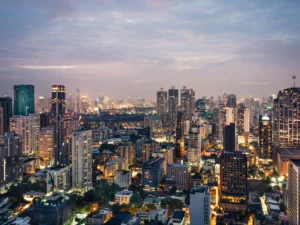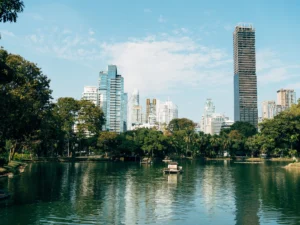There are so many incredible things to do in Bali that it can be hard to prepare a travel itinerary to spend 14 days on the Island of the Gods. We designed a perfect 2-week itinerary in Bali with the best things to do for a first trip and the reason why avoiding certain areas even though they may be tempting on Instagram. You will make many memories even though these 2 magical weeks will pass quickly!
Good to know for an itinerary of 14 days in Bali, Indonesia
- Visa
- Plug outlets
- Internet connectivity
- Taxi
- Payments
- Plane tickets
- Etiquette
1. Do I need a visa to stay 2 weeks in Bali?
Visa On Arrival. US and UE Citizens can get a visa-on-arrival in Bali, Indonesia. You must pay a fee to get the visa on arrival, put it on your passport, and head for border control. There is usually a queue, so expect to wait for an hour. Consider applying for an e-visa beforehand to skip the queue.
2. Plug outlets
Indonesia uses electricity sockets type C and F. The voltage is 230V.
Europe. Plugs used in Europe are usually type C and F. You will certainly not need an adapter.
US, Canada, Mexico. US plug type A or B (grounded) are NOT compatible with the sockets in Bali, Indonesia. You need an adapter (see prices here). Moreover, the voltage is 230V, while 120V is in the US. It means you must check that your device is compatible with this voltage. Nowadays, most devices are built to be compatible with the US (120V) and the rest of the world (220V – 240V) voltage. See here an adapter with a voltage converter.
UK, Singapore, UAE, Qatar, Saudi Arabia. The Type G plugs are incompatible with electricity sockets in Bali, Indonesia. You will need an adapter.
Pro tip. Buy one adapter, and pack a power strip to power all your devices simultaneously.
3. How do you get Internet connectivity in Bali, Indonesia?
It is always helpful to have Internet connectivity while traveling. It is especially true on a 2-week itinerary in Bali. For instance, locate yourself with Google Maps, order a Gojek, and read information about a place. Here are the best ways to get online in Bali.
Roaming. Roaming is the easiest way to get Internet connectivity in Bali. It is also costly. Prices depend on your provider. For instance, AT&T has an International Pass for 10$ a day. So it will cost you 140$ to get Internet connectivity with roaming.
Free WiFi. There is Free WiFi in many cafés and restaurants. Surprisingly, the WiFi is often excellent, whether in Canggu, Ubud, or Seminyak. That’s a reason why Bali is a great place for digital nomads. In remote areas, it can get spotty. For instance, in Munduk or Nusa Penida. Here, the WiFi is often a 4G data plan.
Pocket WiFi Box. Pocket WiFi boxes are small battery-powered devices you keep with you every day. It is a 4G modem that shares its Internet on a private WiFi. You can then connect all your devices to this private WiFi. You can rent a Pocket WiFi Box in many places or have it delivered to your hotel when you arrive. The rent covers Internet usage, so you won’t have an unexpected fee later. The drawback is that you need to recharge this device daily and hope it stays on the entire day. Prices are about 100$ for 14 days in Bali. See prices here.
Local SIM. You can buy a SIM when you arrive. It is usually cheap. The drawback is that you must find a seller when you arrive. Store your SIM in a safe location to avoid losing it. Since you have a new number, it also messes up your iMessage/FaceTime configuration. Lastly, you must change the SIM if you need to connect somewhere where you receive a 2FA code on your phone. It’s not convenient at all.
Local eSIM. eSIMs are virtual SIM cards. To install an eSIM on your phone, you only need to download it. Your smartphone must be compatible. It has worked on the iPhone since the Xs/XR was released in September 2018. Since it is a virtual SIM, you don’t need to remove yours. An eSIM is dirt-cheap and very easy to use. Since it is installed on your phone, it works flawlessly. An eSIM for 14 days in Bali with 2Go of data costs 8$. It is the cheapest option to get online in Bali. We recommend buying an eSIM on the Airalo app, which we use. See prices here.
4. Payments in Bali, Indonesia
Credit Card. Bali’s only currency is the Indonesian Rupiah (IDR). Credit cards are accepted in most hotels and restaurants, especially Visa and Mastercard. You can rely only on a credit card and must always have some cash.
Apple Pay. Apple Pay is accepted almost wherever you can already pay by credit card.
Cash. You can get cash in any ATM. It may not find ATMs in remote areas. Plan in advance and withdraw cash at the airport. Your bank provider can charge you for withdrawing in another country or currency.
kIDR. 1$ is about 15000 IDR. You may often price in kIDR (thousands of Indonesian Rupiah). 15000IDR is 15kIDR. It is easier to read and understand.
5. Taxi in Bali
Taxi. Taxis are rare in the street. You can get a taxi at the airport, or get your hotel to call you one. You will often find people in the street proposing taxi services. For example, there is always somebody in front of Ubud Palace. You need to set a price in advance for your destination as there are no meters.
Uber, Gojek, Grab. Uber is not available in Bali, Indonesia. Gojek and Grab are the Uber-like apps. There are often drivers available. You can also order food and order a scooter taxi for 1 person. Gojek and Grab are forbidden to pick up customers in some areas, for instance, in front of Alas Harum. You always find someone proposing a taxi service in these areas, with a higher price. We will use many times Gojek and Grab during this 2-week itinerary in Bali.
Whatsapp. Whatsapp is widely used in Bali. Hosts, guides, and drivers will contact you by WhatsApp to confirm a booking or to give information. If you are not already using WhatsApp, installing it and setting up an account before arriving is better.
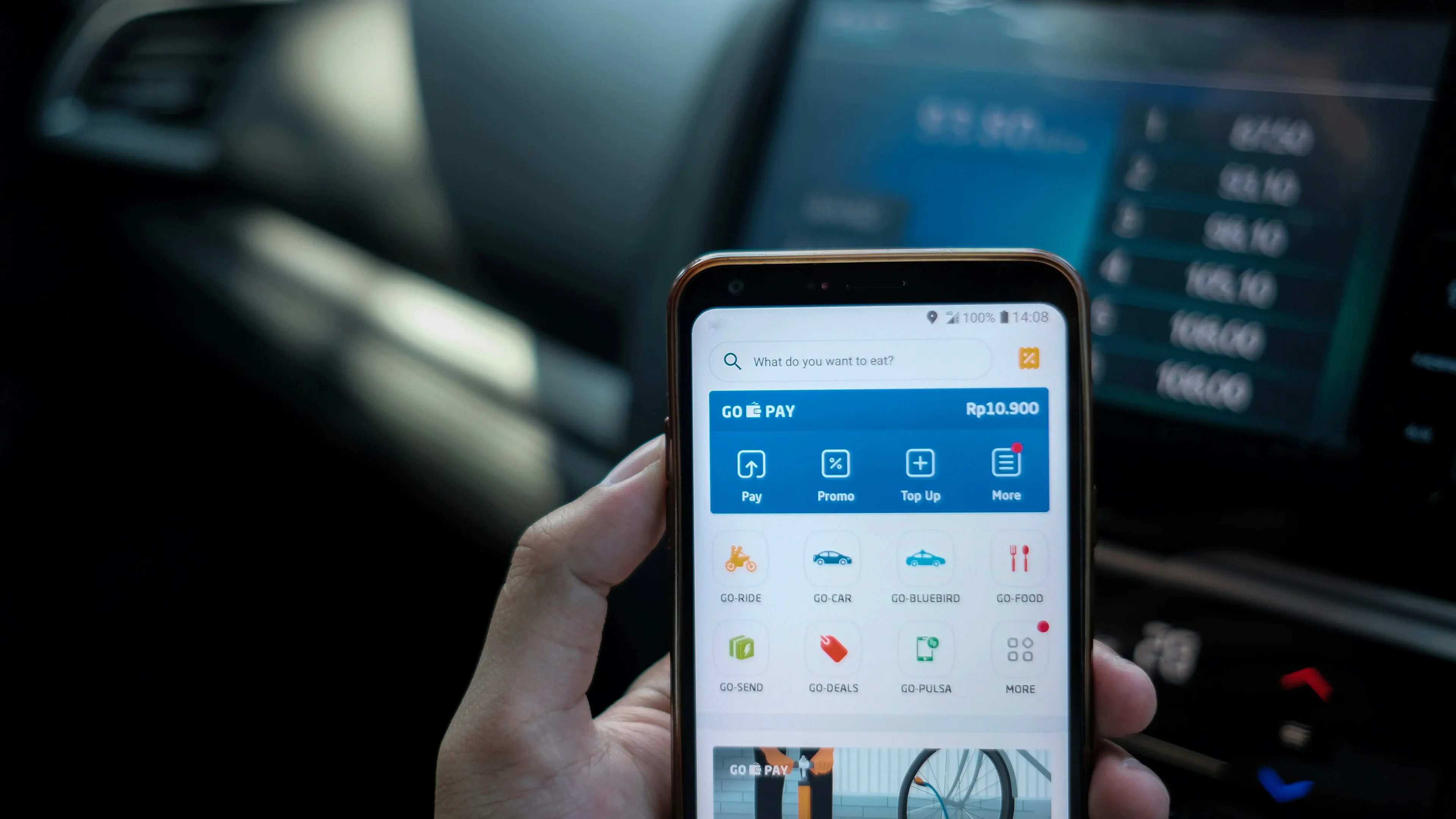
6. Move around in Bali
Public Transportation. There are few public transportation in Bali. It is oriented toward the local people, so we recommend not using it, especially with luggage. There are 5 lines. Service started in 2020, so you may read on outdated blogs that there is no public transportation in Bali. See the official network map here.
Driver. The best way to move around in Bali is with a private driver. You can order one with Gojek. Many taxis (booked with Grab/Gojek or at the airport) will also offer you their driver service.
7. Plane tickets
Finding the ticket. Google Flights is the site to go for finding the best plane ticket. There are few international direct routes from the US, Canada or Europe. You will probably need to make a stopover in Dubaï, Tokyo, Singapore, or Bangkok.
Book on the company site. Always book your plane ticket on the company site directly. When using travel agencies to buy your tickets, you can get fewer services, for example, no choice of seating. When problems happen, it is always a hassle with intermediaries, whereas the company usually has good customer service.
Airport. There is 1 airport in Bali. Traffic is awful in Bali, especially in the Denpasar area. Expect to be stuck in traffic.
8. Etiquette
Tip. Prices in restaurants and cafes can be shown with or without service and TVA. You will sometimes find a line saying “10% service + 10% tax not included”, meaning the final price will be 20% higher than shown. Tipping over the final amount is not required. Thus, tipping is a clear sign you enjoyed the service. A 10% tip is a great tip.
Language. It is always welcome when a foreigner tries to speak the local language. But it is challenging in Bali. People can speak Balinese and Bahasa Indonesia. You can try to say a few words in Balinese, but the people you try to talk to may not understand, as they only speak Bahasa Indonesia. It is especially the case where the immigration from other islands is substantial, for instance, Canggu, Seminyak, and Kuta. In Ubud or Munduk, you will encounter more native people talking Balinese and eating Babi Guling.
Many people speak at least basic English, so you can expect everyone to understand you.
The best time to visit Bali on a 2-week itinerary
April to October. The best time for this 2-week itinerary in Bali, Indonesia, is from April to October. It is the dry season in Bali. It may rain at night, but rarely during the day. The perfect climate to visit Bali. July and August are the peak tourist season. Accommodation prices will be higher.
March and November. While not the dry season, it is still not quite the rainy season. It will rain some days, but you can still enjoy many great days. Accommodations are cheaper than during the dry season.
December, January and February. It is the rainy season. Expect rain at least every other day. It is still hot, and the humidity is higher. Thus, it feels stifling. Low-cost accommodations will also smell bad due to the moisture. You can still enjoy a great vacation if you know what to expect.
14 days in Bali: a 2-week itinerary
Here is a 2-week itinerary, day by day, to discover the wonderful Bali island. Click here to see the best things to do in Bali.
Day 1-4: Seminyak
When arriving in a new country, take a few days to accomodate yourself with the place. You are in a new environment that you don’t know at all. Customs are different. Thus, we chose to arrive and spend a few days in Seminyak. It is the best beach to watch sunsets in Bali.
Visa on Arrival. If you did not apply for an e-visa beforehand, you must pay for the visa on arrival. It is better to have cash in dollars to pay for it. There is always a queue for paying for the visa on arrival, so you will lose some time here. That’s why we recommend applying for the e-visa beforehand.
Airport Transfer. Book your airport transfer in advance. When arriving at Bali airport, you will be heavily solicited by drivers with unbelievably high prices. Furthermore, it is hard to explain the place where you want to go, especially if it is not a big resort. There is a taxi stand, but there is always a huge queue. The best way is to book a transfer in advance at a reasonable price, with the destination already planned (click here to see the prices).
Day trips and activities. You can take day trips from Seminyak to visit Bali’s north and west sides:
- Jatiluwih Rice Terrace + Ulan Danu Bratan
- Beach and surf lesson
- Lovina Beach: Dolphins + snorkeling
- Ayung River Rafting
- Spa treatment
- Zoo, Safari, or Bird park
1. Day-trip to Jatiluwih Rice Terrace and Ulan Danu Bratan
For this day trip to Jatiluwih Rice Terrace and Ulan Danu Bratan temple, the best way is to book a private driver. Drivers from Grab or Gojek usually propose their private driver services. So, if you already had a ride, you may already have a Whatsapp contact to book a private driver for a day. Otherwise, you can always book one in advance online (see prices here). Another option is booking a tour. There are private and grouped tours. Grouped ones are cheaper, but you cannot entirely enjoy a place since you have a schedule to follow. A grouped tour is not great for visiting Jatiluwih Rice Terrace and Ulan Danu Bratan temple.
- Private driver booked online: see availability here
- Private tour: see reviews here
Jatiluwih Rice Terrace. The most extensive Rice Terrace in Bali and one of the most beautiful. You can easily spend 2 to 3 hours here. There is a wonderful hiking trail in the heart of the Jatiluwih rice terrace. Read our complete guide for visiting the Jatiluwih Rice Terrace here.
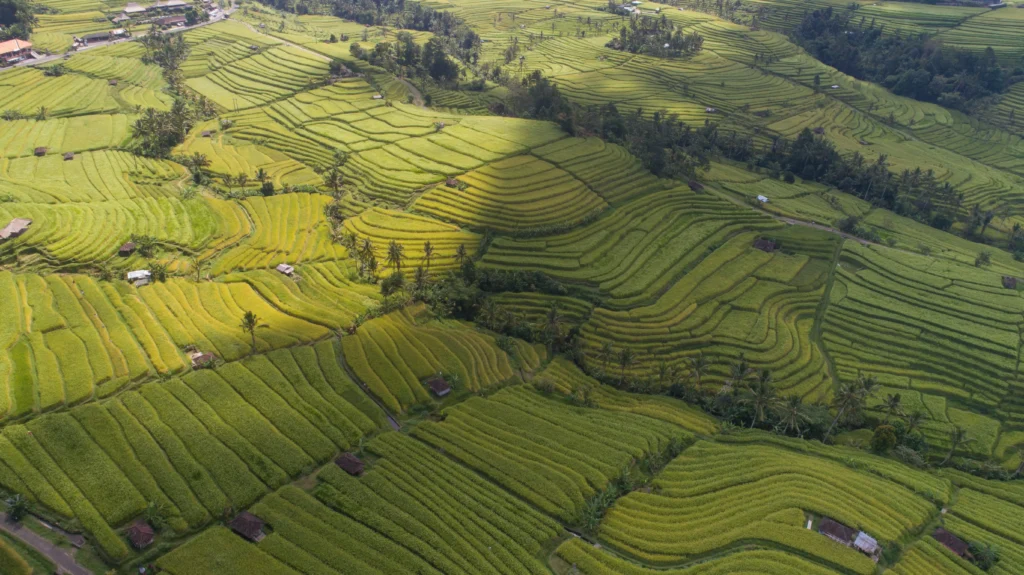
Ulan Danu Bratan Temple. One of the most famous temples in Bali! It is on the lake and surrounded by mountains. A must-visit in Bali on a 2-week itinerary. You can take marvelous photos here and watch a religious ceremony if lucky!

Other places on this day trip. With a private driver, you can go anywhere you want. Here are some other places that can easily fit on this day trip.
- Handara Gate: an iconic gate. You can take here an Instagram-famous photo. There is nothing else to do here. You will only find parking, a cashier, and a queue to take a photo here.
- An Instagram photo place. There are multiple places on the Wanigiri road, with the lake and the mountains behind. You will find photo spots with a boat, a swing, and bird nests. It’s great for photos, but if it’s not your cup of tea, it’s not worth it.
- Waterfalls. Bali has many waterfalls. Some of the best waterfalls are along this day trip: Banyumala, Auman, Git Git, and Nungnung.
- Tanah Lot: the famous temple by the sea. It is a great visit, but you may have little time to visit it, so we scheduled this visit at the end of the trip when staying at Canggu.
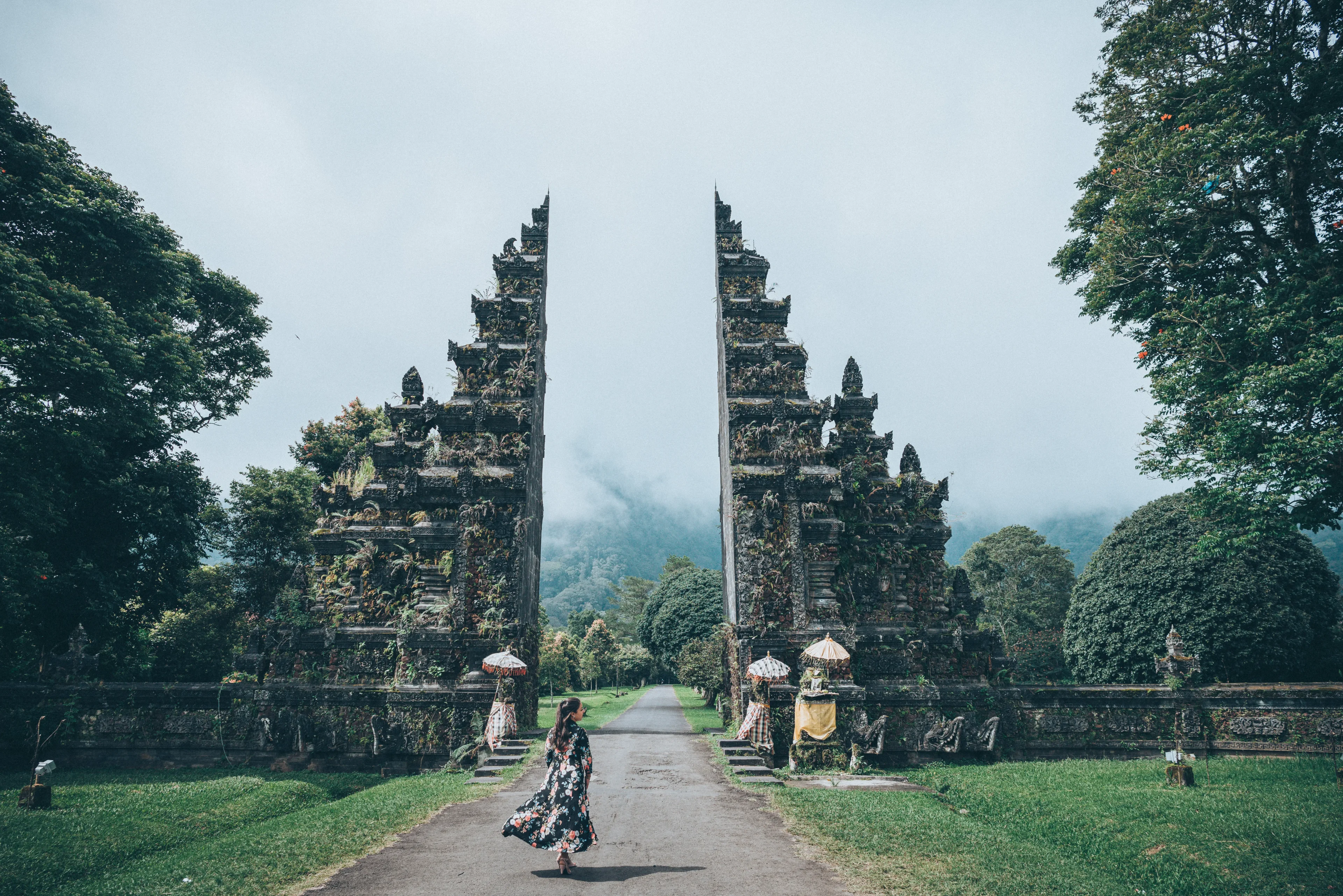
2. Beach and surf lesson
Bali is a wonderful spot for surfers, especially beginners. There are always surfable waves. For advanced surfers, you can go further away from the beach to find bigger waves. It is also a great spot for beginners because the rip current is often mild. Thus, it is safer than other places in the world.
The drawback is for non-surfers. A vast part of the beach is reserved for surfers, and swimming in this area is forbidden. A small space is reserved for swimmers.
Surf lessons. There are surf schools everywhere on the beach. They rent the equipment, teach you the base on the beach, and then coach you on the sea. It is a great place to start learning to surf.
Lounge chairs and umbrellas. The beach is large and wide. There are many lines of lounge chairs and umbrellas that you can rent for the day. While enjoying the beach, you will be solicited many times by scarf sellers, painting sellers, or masseuse.
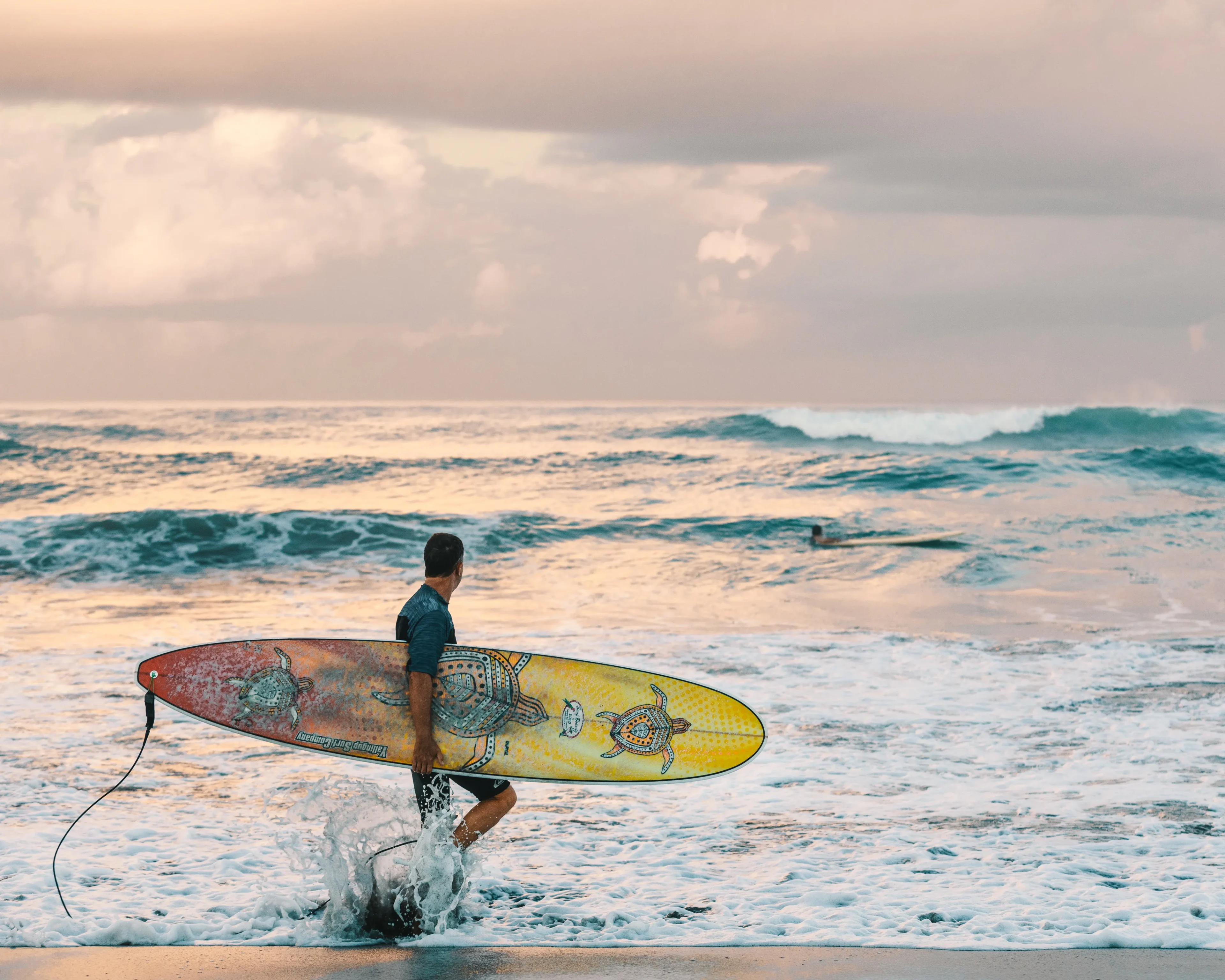
3. Sunset and evening on Pantai Seminyak
The best sunsets in Bali are in the Seminyak beach: Pantai Seminyak. As the sun sets, it will slowly disappear behind the sea. There are often some clouds in Bali, making the sunsets even more gorgeous, with orange lights.
How to enjoy the sunset. Sit on a bean bag with a refreshing drink while listening to your favorite music. There are many bars with different kinds of music: live, old, and electro. You can even eat on the beach or continue the party until late at night.
On this 2-week itinerary in Bali, you will have multiple incredible sunset spots in Mount Batur, Nusa Penida, and Ubud.

4. Day trip to Lovina Beach to watch dolphins and snorkel
Lovina Beach is located on the north side of Bali. You will cross the entire island. It is best to book a tour for this activity since once in Lovina Beach, you must take a boat to watch dolphins and snorkel. Thus, it is better when everything is organized jointly. See prices here.
Lovina Beach. You can visit and stay at Lovina Beach on your 2nd or 3rd trip to Bali. For a first time in Bali, there are better places to stay, for instance, the ones on this 2-week itinerary in Bali.
Dolphins. Many dolphins live in an area north of Bali. A boat will take you to meet them in their natural environment.
Snorkeling. Colorful fishes also live in the Bali Sea. Since the water is quite translucid, you can do snorkeling and see plenty of gorgeous fish.
5. Ayung River Rafting
For thrill-seekers, you can enjoy rafting in the Ayung River. Apart from the fun, this activity is also great for watching stunning waterfalls and breathtaking gorges in the lush rainforest of Bali. See prices here.
6. Spa treatment
One of the most famous activities in Bali is the spa. There are spa salons everywhere, and the quality is outstanding. Many travelers enjoy multiple spa treatments during 14 days in Bali. In Seminyak, you can go to Lluvia. (See the places on Google Maps here – see the prices there).
7. Zoo, Safari, and Bird park
When traveling to Bali with the family, a day in a Zoo, a Safari, or a Bird park is a great way to entertain everyone. There are 3 places in Bali with incredible experiences, like having breakfast with Orangutans or feeding birds and taking a photo with them:
Day 4-9: Ubud
Ubud is the spiritual heart of Bali. It is a whole new atmosphere here. It is more Bali than in the south of the island. There are fewer migrants from other parts of Indonesia and more Balinese natives. In front of every shop, you will find a little offering made of rice on a banana leaf plate. If you are lucky, you may also encounter religious processions on the street or in a temple.
Ubud is also home to many yogis on a retreat in Bali for 1 or 2 weeks. On a first trip to Bali, there are so many things to do that you won’t have the time for a yoga retreat.
On this 2-week itinerary in Bali, Ubud is where we stay the longest. It is perfect for enjoying Ubud and the countryside of Bali:
- Ubud, the Sacred Monkey Forest, Art Market, and Ubud Palace
- Spa treatments in rice fields
- Hikes in rice fields
- Kecak Fire Show and other shows
- Tegallalang Rice Terrace (day trip with Tirta Empul temple, Waterfalls, Kopi Luwak farm, and Kintanami)
- Mount Batur sunset trekking
- East Bali tour (Tirta Gangga, Lempuyang, Besakih)
Click here to see the best things to do in Ubud.
How to get to Ubud from Seminyak. The best way to go to Ubud from Seminyak is by calling a Gojek, a Grab, or a Taxi. Rates are affordable in Bali.
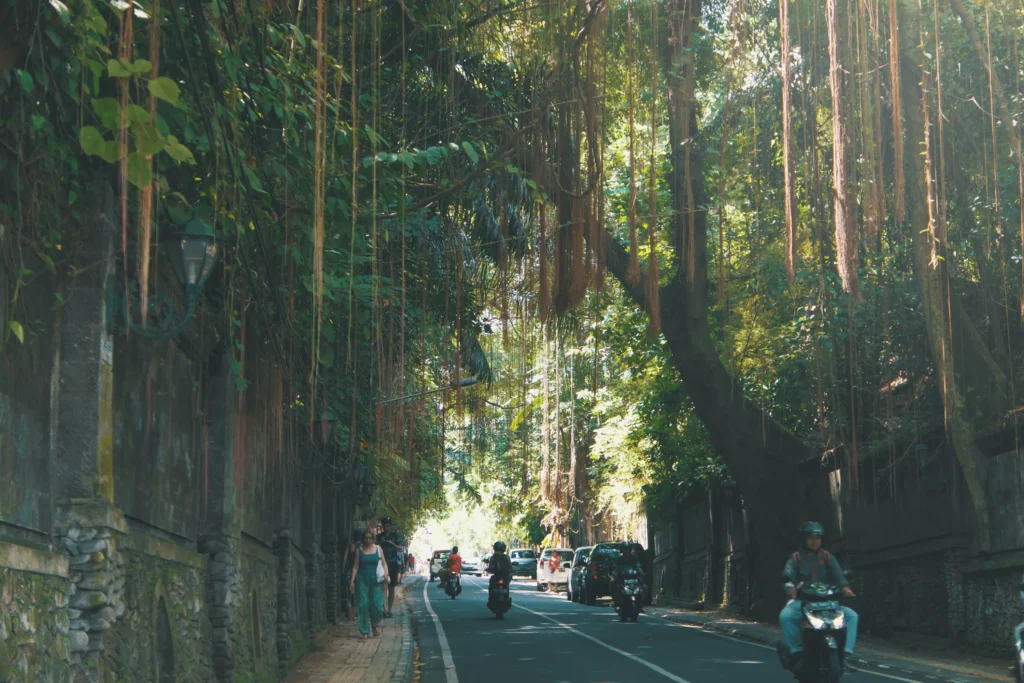
Accommodation in Ubud. Ubud is a vast area. You can book a place to stay in Ubud, far from the center. You will thus need a scooter. It is best to choose accommodation in the center of Ubud to get around on foot, for instance, the SenS hotel. Another great option is booking accommodation to stay in Ubud with a shuttle service to the center, for instance, the Best Western Premier. You can also stay in the middle of rice fields, a few minutes away from Ubud, for instance, in Luxe Villas. Some of Ubud’s most incredible places to stay are further away from the city center and deep in the lush vegetation, for instance, the Four Seasons or the Buahan.
Click here to read our guide for the best places to stay in Ubud.
1. Visiting Ubud, the Sacred Monkey Forest, the Art Market, and Ubud Royal Palace
Ubud itself is worth visiting. It is a nice town with tiny streets full of local shops, cafés and restaurants. Walking along Goutama Street is highly enjoyable. You will find on this street the best warung (local restaurant) to taste typical Balinese cuisine: In Da Compound. The warung is away from the road, and you must enter what seems like someone’s home! Pro tip: you can also order food from this warung on Grab. You may want to eat authentic Balinese cuisine on this 2-week itinerary in Bali.
Ubud Art Market. Many stalls sell all types of Balinese products. It is usually in front of the Ubud Palace and along the Karna street. The place is being rebuilt and is, for the time being, along Kajeng and Arjuna streets.
Ubud Royal Palace. The place is small, but it is free. It is a great way to discover Balinese art and religious beliefs. Traditional dance shows take place here every evening.
Sacred Monkey Forest. Imagine hundreds of monkeys in deep, lush vegetation with a temple directly in Ubud. The Sacred Monkey Forest is Ubud’s gem. It is worth a visit, even if you come only for it. A unique experience. Monkeys are not tamed but accustomed to humans. They will steal any small objects you have, like a smartphone. And if you have food in your bag, they will harass you until you give them what they want. Take precautions and hide any small objects. Because the monkeys are wild, you can encounter them before entering the Monkey Forest. Nonetheless, it is a great experience, and guards are everything to protect you when a monkey may be aggressive. Read here our complete guide for the Sacred Monkey Forest.
Goa Gajah. Also known as the Elephant Cave. It was a Buddhist temple, then transformed into a Hindu temple. Thus, you will find Ganesh and Buddha together here. The park is beautiful, so don’t miss it. You can come here with a private driver or with a scooter. See the location here.

2. Spa treatments in rice fields
If you already had a spa treatment in Seminyak, there are 2 options: it was fantastic, and you want to try another, or it was not great, and you want to try a better one.
In Ubud, you can experience a spa massage in the middle of rice fields. The atmosphere is much more peaceful and connected with the surrounding nature.
Here are some of the best spas in Ubud in rice fields or the nature:
3. Hikes in rice fields
One of the best things to do in Ubud is a free one! Hiking in the beautiful rice fields is a unique experience. There are 3 main hiking trails accessible from Ubud’s center: Campuhan Ridge, Kajeng, and Sari.
Campuhan Ridge Walk is the most famous. Nonetheless, you should read our comparison of the 3 best hikes in Ubud to know the one that fits your expectations.
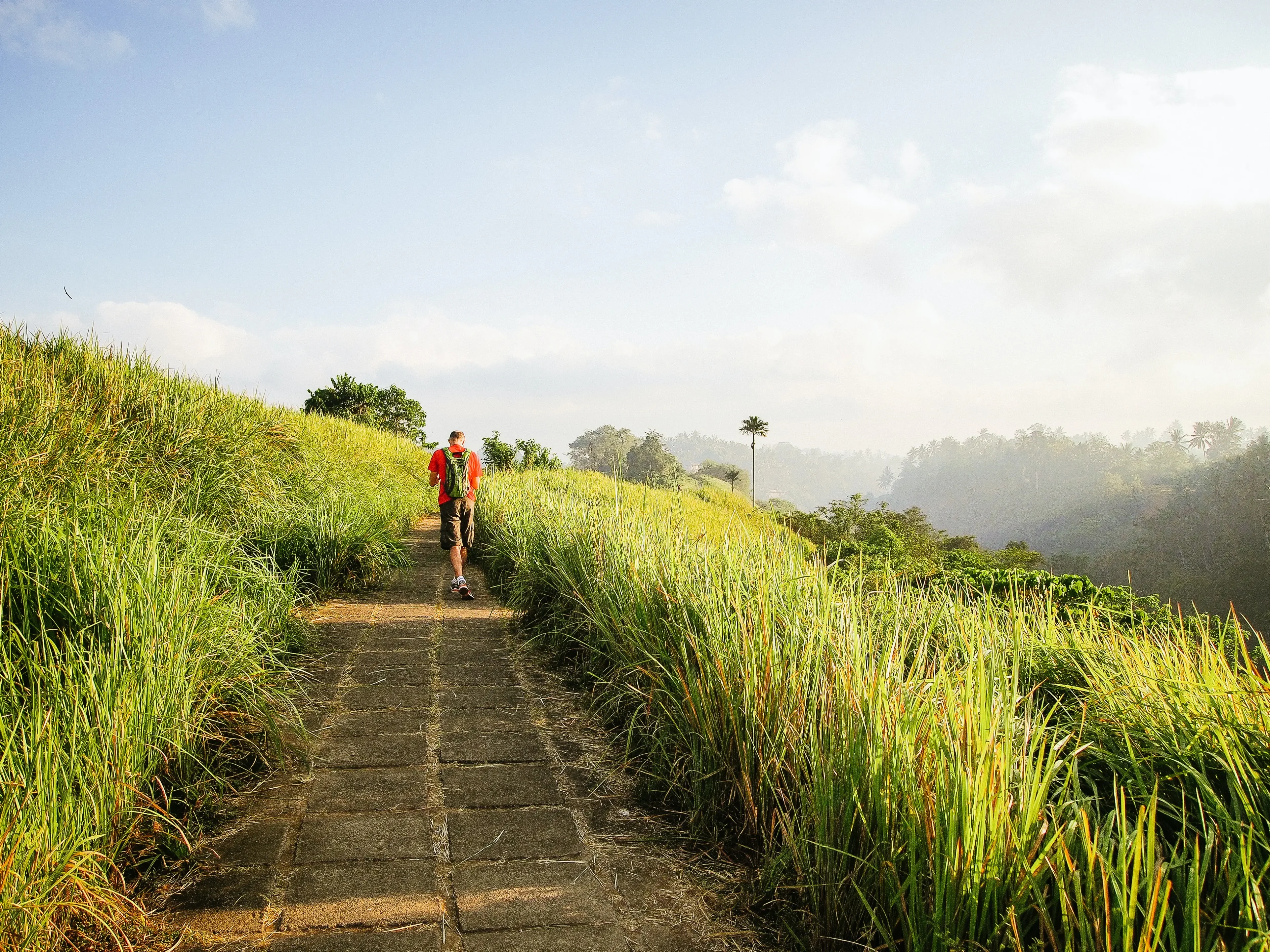
4. Kecak fire dance and other shows
In Ubud, there are shows every night of the week. There is a show every evening in Ubud Palace and other shows in other temples. Tickets are sold in the street during the day. There is 2 kind of shows: the Balinese dance and the Kecak fire dance.
Balinese dance. These dance shows include live traditional Balinese music with the Gamelan. The dance depicts epic Balinese tales. There are multiple dancers, beautiful costumes, and the music that goes with it. The typical Legong dance, the one with the mesmerizing finger movement, is often represented.
Kecak fire dance. There are no musical instruments for the Kecak fire dance, only the vocals from many men. Their chants are captivating. Shows occur at Pura Dalem every Monday and Friday at 19:30. Tickets are bought at the entrance, so come in advance to sit on the first row.
It is not the only place with this show. You will find ticket sellers on the street daily with the same show in another place.
Ubud is the best place to watch these performances. You can also find these shows in the south of Bali, for example, in Tanah Lot. Unfortunately, the quality is lower. For instance, you can have about 40 men singing for the Kecak fire dance in Ubud and only 10 in Tanah Lot. It has not the same effect! A visit to the Tanah Lot temple is later scheduled on this 2-week itinerary in Bali. Shows are also great at Uluwatu temple but are usually very crowded.
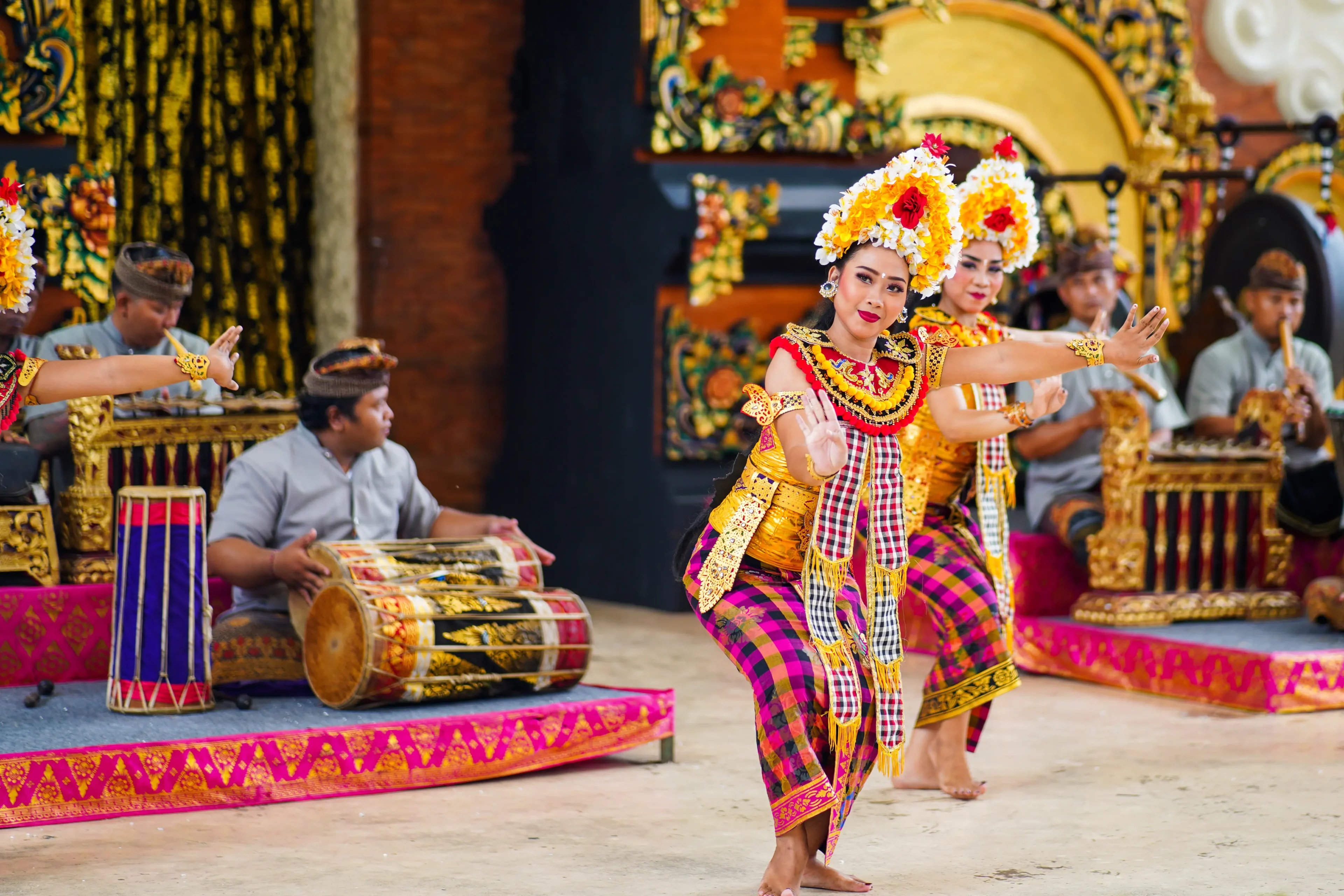
5. Tegallang Rice Terrace on a day trip with the Tirta Empul temple, waterfalls, a Kopi Luwak plantation, Kintamani and Goa Gajah
The Tegallalang Rice Terrace is a unique landscape. The particularity is the steepness of the terrace. Tegallalang in Bali is the only rice terrace as steep. It does not look like the Jatiluwih Rice Terrace but it is just as beautiful. Tegallalang is a few kilometers northwards of Ubud. You can go there by scooter or by taxi. Click here to read our complete guide for the Tegallalang Rice Terrace.
You can make a day trip with the Tegallalang Rice Terrace and other places nearby. There are many incredible things to do. You can take a private driver to visit these places on Grab, Gojek or book online in advance (see prices here).
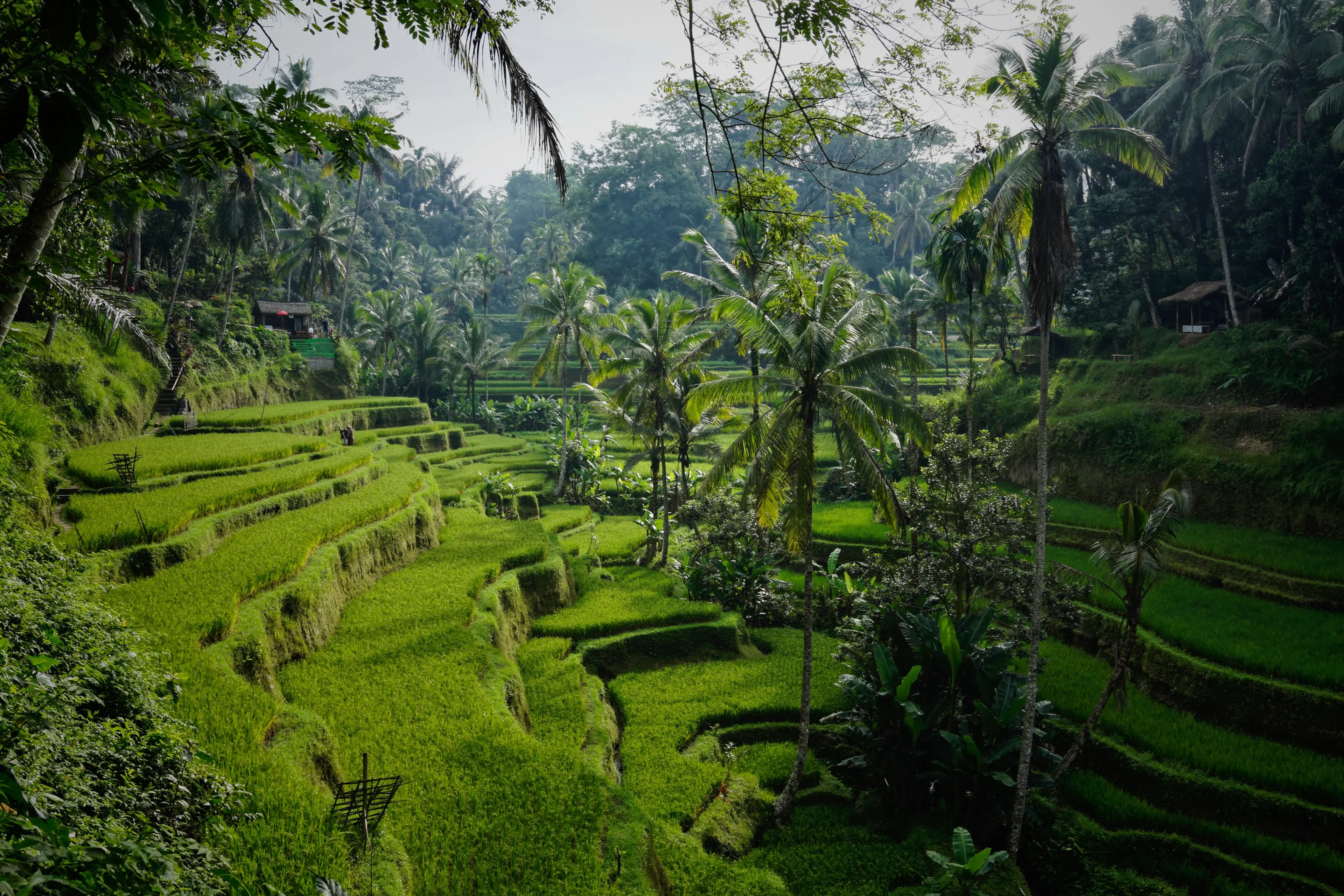
Tirta Empul temple. The Tirta Empul temple is a marvelous religious place to visit near Ubud. Balinese come here to cleanse themselves with the holy water from the temple. You can also experience the cleansing ceremony for a fee. Even if you only come to watch, it is worth the visit. The temple is beautiful. The water flows everywhere.
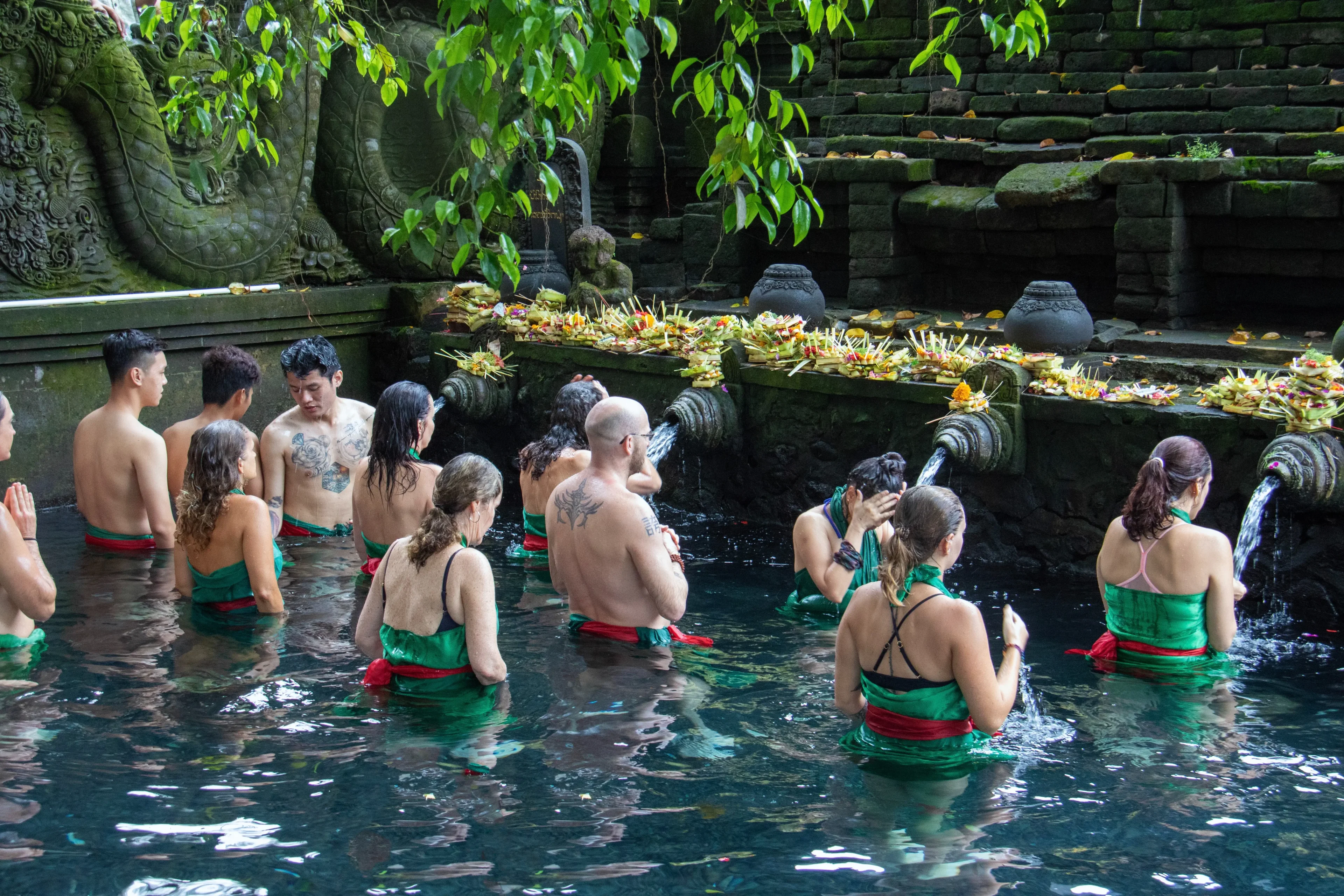
Waterfalls. There are many waterfalls in Bali. Some waterfalls are nearby: the Tangkup and the Manuaba. You can skip it if you are not fond of waterfalls and have already seen one while visiting Ulan Danu Bratan temple.
Kopi Luwak plantation. The most expensive coffee in the world is from Bali. An animal harvests it, the Asian palm civet. He eats the best coffee cherry and rejects the coffee bean. Kopi luwak coffee is made from the coffee bean found in the excrement. There are many plantations in Bali. Unfortunately, many exploit the civets for a tourist show. For an authentic and ethical plantation, you can go to the Abian Kusuma Sari Agrowisata.
Kintamani. Kintamani is a town on a cliff near Mount Batur. There are many coffee places here where you can have a majestic view. The view is truly breathtaking. You can stop at Akasa Coffee, Montana Del Cafe, or Tegukopi for the best places with impressive sights. There is also a free observation deck, which is less enjoyable since you cannot sit and marvel peacefully at the landscape. Lastly, you can also visit the Ulan Danu Batur temple.
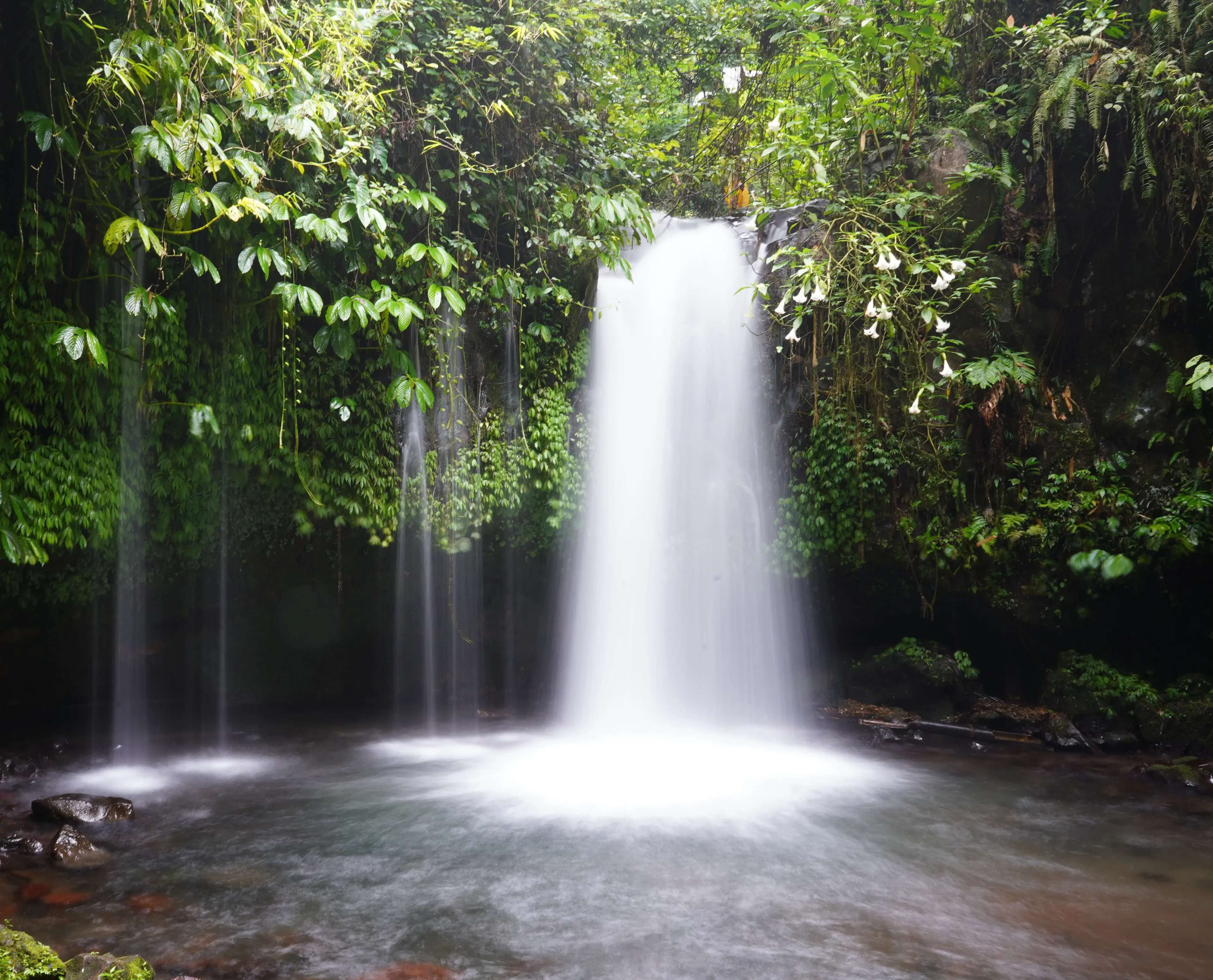
6. Mount Batur sunset trekking
What a unique experience in Bali during this 2-week itinerary! You will wake up around 3 a.m. Then, you will head to Kintamani and the Mount Batur. A 2-hour hike awaits you to climb the Mount Batur. It is in the darkness, so you need torches and sticks. It is not a hard hike, but you must have a reasonable fitness level to complete it before sunrise.
When you arrive, marveling at the sun slowly rising east is a unique sensation.
It is best to do this activity when staying in Ubud, as you can wake up later. When staying south of Bali, you must wake up as early as 1 a.m.
It can be dangerous to hike by yourself. You will be in darkness most of the time, and the trail can be slippery. Take a local guide to help you with this experience (see prices here).
7. East Bali tour with Tirta Gangga temple, Lempuyang temple, and the Heaven Gate.
The east side of Bali also has some incredible attractions worth a visit. On this 2-week itinerary, it is best to visit the east side of Bali from Ubud since it is closer. If you like visiting Balinese temples, you will love this day with 3 of the most impressive temples in Bali.
Pura Agung Besakih. Beskih is the mother temple of all temples in Bali. It is the most important Hindu site in Bali. Every Balinese comes here once a year to pray. There are also giant processions every 10 and 100 years. The temple of Besakih is one of the highest in Bali, on the slopes of Mount Agung. See its location here.
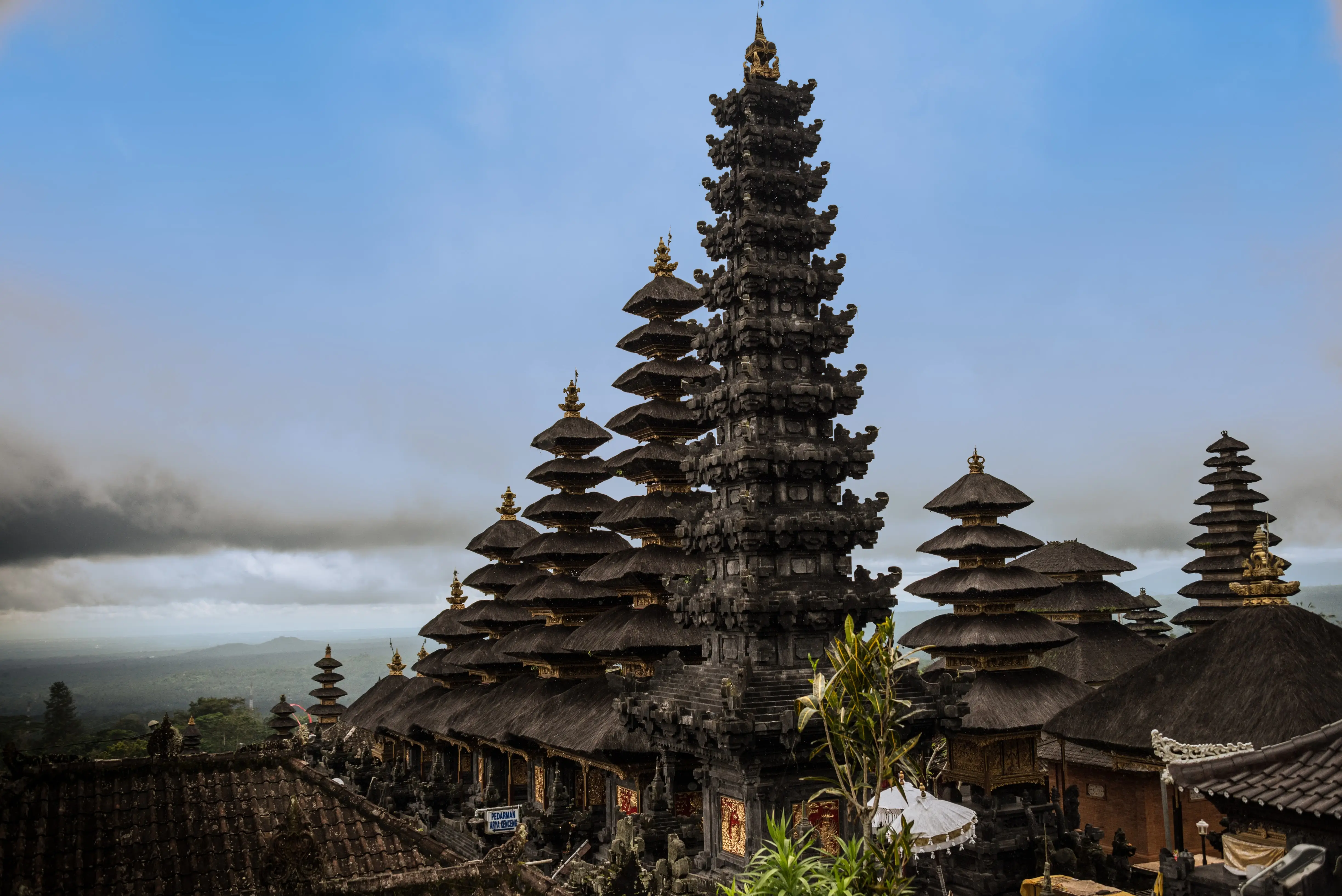
Tirta Gangga. A beautiful water palace! The holy waters are supposed to have a healing power. The place is very photogenic. You may already have seen it on Instagram. Thus, it is a very popular place for tourists. See its location here.
Lempuyang temple. The highest temple in Bali. You have a clear view of Mount Agung when the weather is clear. The heaven gate is directly aligned with Mount Agung. Thus, the setting is ideal for a perfect photo. A numbered queue is organized to take this photo, so expect to wait a few hours for this great shot. For this reason, the place can seem overrated nowadays. See its location here.
Taman Ujung. Another water palace. Travelers often find Tirta Gangga more beautiful and impressive, but Taman Ujung is much quieter. Hence, you can enjoy the place more. If you don’t mind crowds, you may prefer Tirtta Gangga. Otherwise, Taman Ujung is a better choice.
The best way to enjoy the east Bali is with a private driver. A cheaper way is by booking a tour (see prices here).
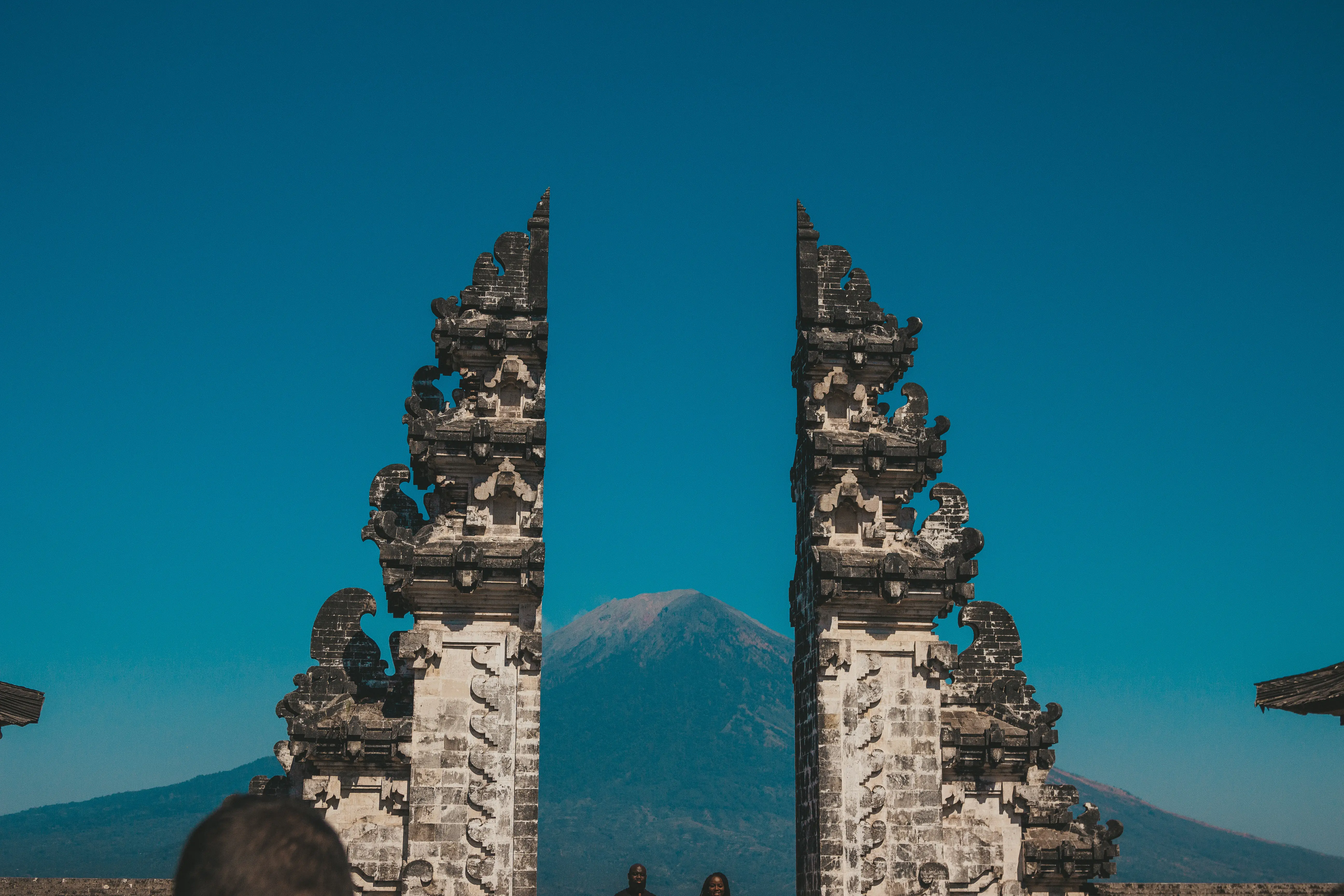
Day 9-12: Nusa Penida & Nusa Lembongan
Nusa Penida and Nusa Lembongan are 2 small islands close to Bali, perfect for visiting on a 2-week itinerary. The landscape is incredible. Nusa Penida is smaller but more developed for tourism, with better hotels.
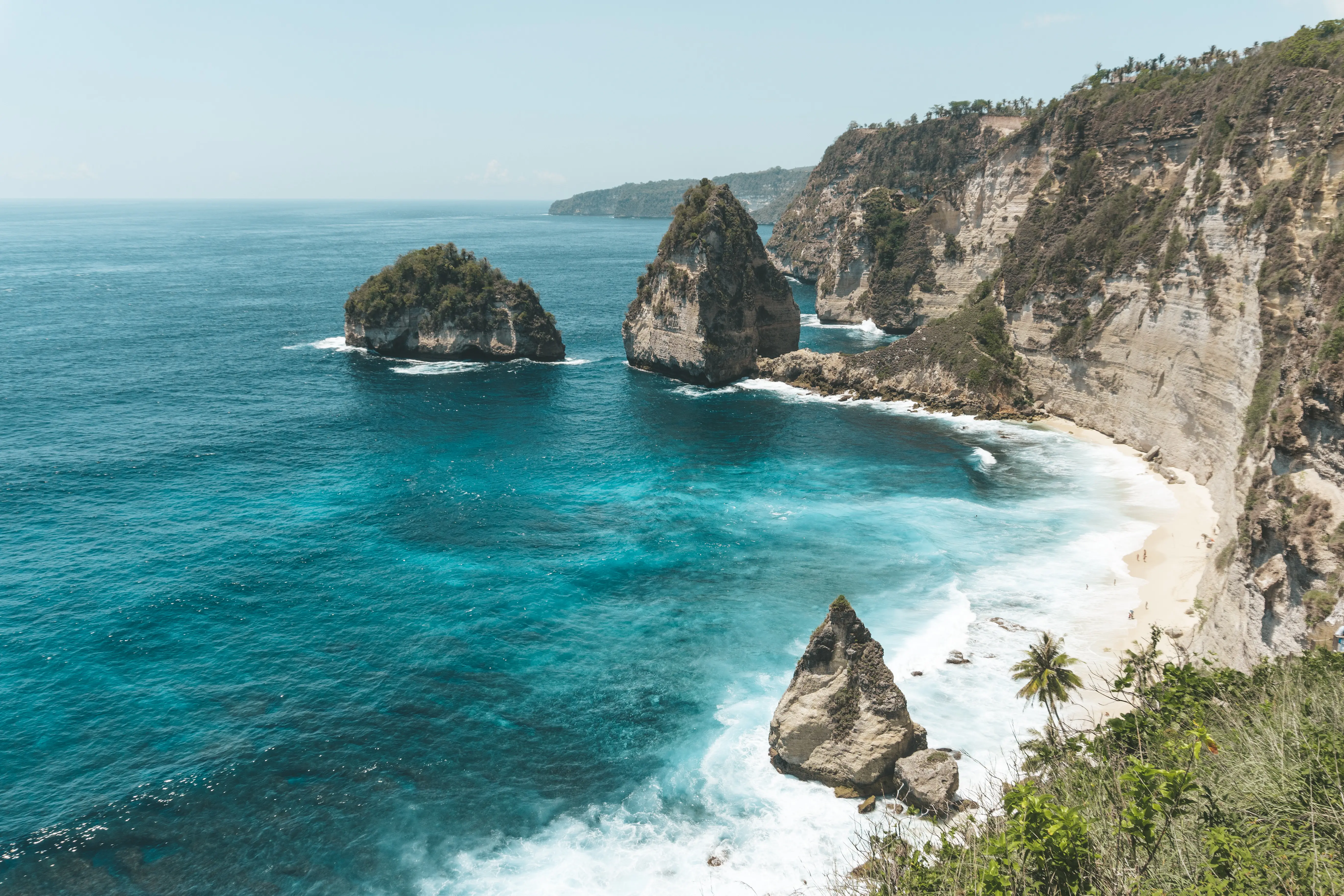
How to get to Nusa Penida or Nusa Lembongan from Ubud. The boat is the best way to go to Nusa Penida or Nusa Lembongan. The harbor is in Sanur. You can take a taxi on Grab or Gojek to go to the Sanur harbor. Travel time by boat is then 45 minutes for Nusa Lembongan. It is pretty fast. Plan for 3 hours total time from Ubud to Nusa Lembongan.
Best place to stay. Nusa Lembongan is a better place to stay. It has more hotels and more places to eat. In Nusa Lembongan, Nusa Verandas villas are a great option (it is on Nusa Ceningan island but connected to Lembongan by a bridge). One of the best places to stay in Nusa Penida is Sawit Garden Cottages.
How to get around. You can rent a scooter in Nusa Lembongan. The island is small, and there is little traffic. The roads can be dangerous, so drive cautiously. Nusa Penida is a bigger island, so it is best to take a private driver. Don’t expect to have a last-minute Gojek or a Grab in Nusa islands, and plan everything in advance.
Nusa Lembongan
Here are the best things to do in Nusa Lembongan.
Devil’s tears. A beautiful panorama in Bali. Also great for sunsets. Here, you just have to sit and marvel at the waves crashing against the rocks. There are multiple places with a small hike. See its location.
Dream beach. A stone’s throw from Devil’s tear, you have the dream beach. The beach is quite beautiful with its white sands. The water here is crystal clear. You can swim and see underwater marine life easily. See the location here.
Blue Lagoon. Cross the bridge and head to Nusa Ceningan. Blue Lagoon has crystal clear water with a mesmerizing turquoise color. The huge waves, the cliffs, and the lush greenery make it a fantastic place. It is also a great place for sunsets. See the location here.
Snorkeling. The crystal-clear water makes it a great place for snorkeling and diving. You can observe manta rays, sea turtles, and sea horses. See prices here.
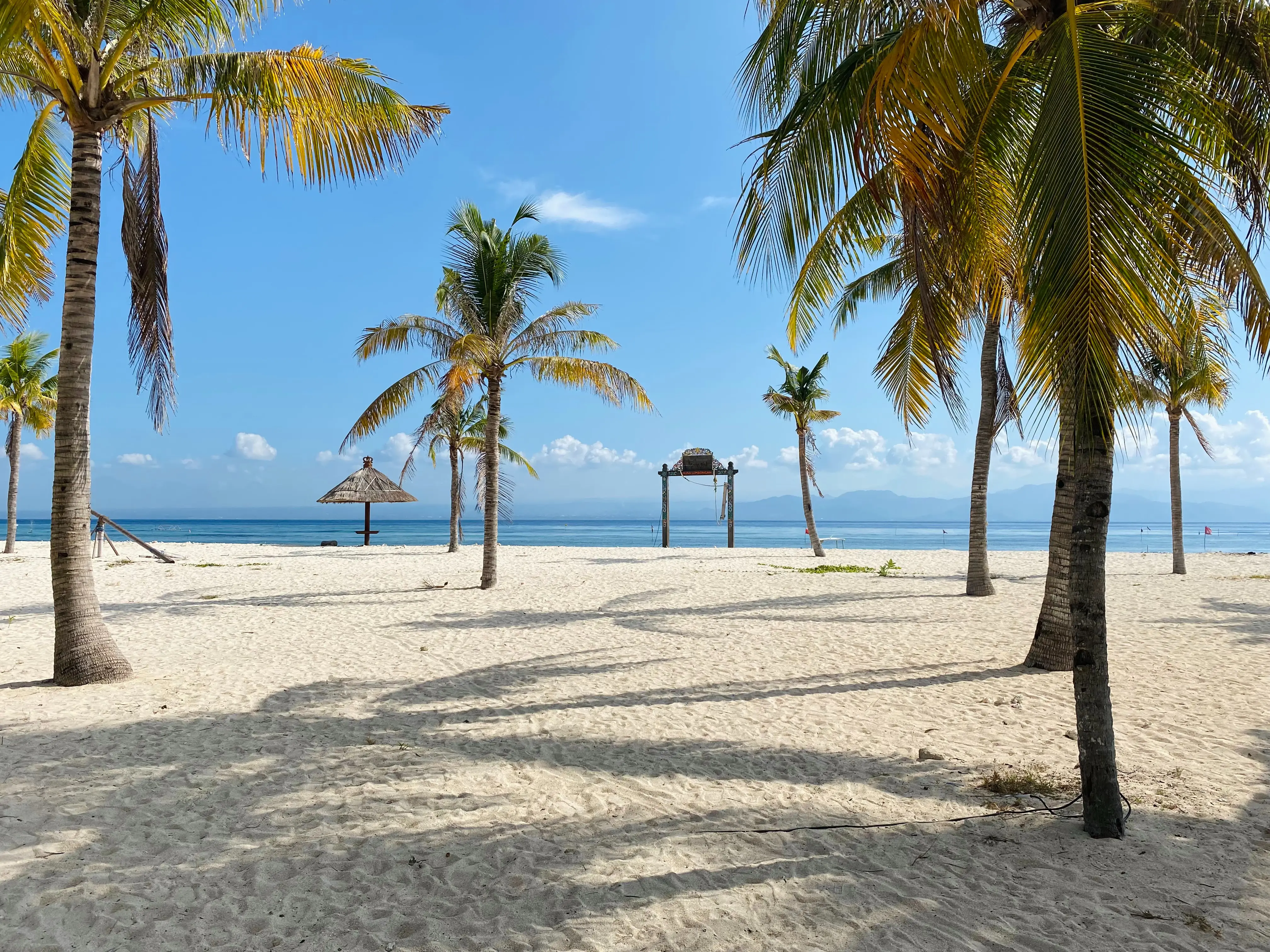
Nusa Penida
You can get to Nusa Penida by boat. You can also choose a sightseeing tour in Nusa Penida from Lembongan (see prices here).
Kelingking beach. One of the most beautiful places on this 2-week itinerary in Bali. It’s beyond words. The view from the hill leaves every traveler in awe. You can hike down to the beach in 30 minutes. If lucky, you could also get a glimpse of graceful manta rays. See the location here.

Broken beach. Another amazing place for unique photos. The hilly rock arch is the gem of the area. The whole scenic coastal formation is beautiful. Angel’s Billabong is nearby and worth the detour. See the location here.
Diamond Beach and Atuh Beach. The two beaches are next to each other, and both are fantastic. You can rent a beach bed and stay here for a few hours. One of the best beaches in Bali. See the location here.
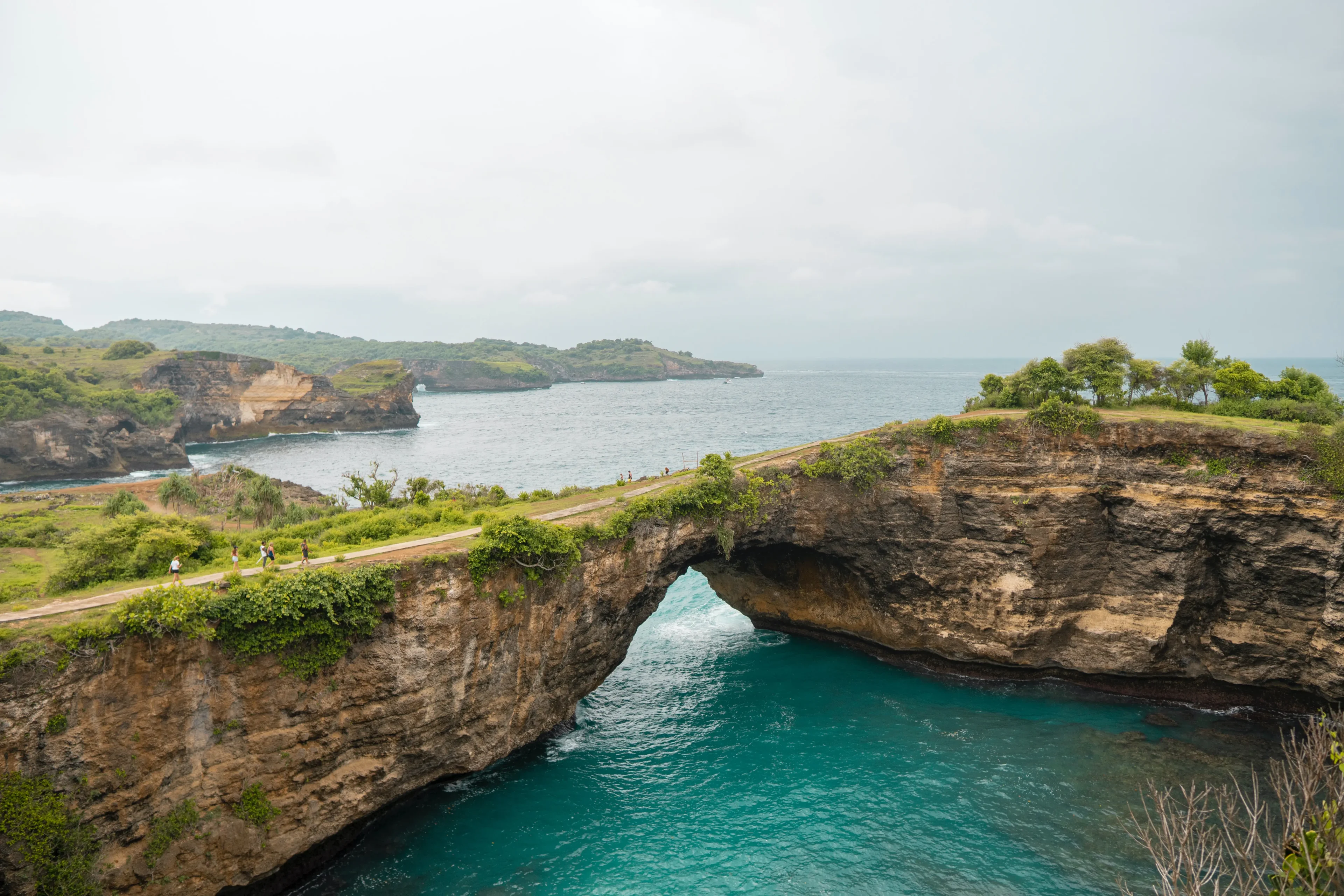
Day 11-14: Canggu
Canggu is one of the best places for digital nomads. Hundreds of digital nomads come and stay for a few months in Canggu. A whole ecosystem is built for them, with many trendy cafés where you can work, incredible gyms, and tasteful restaurants. It is another side of Bali. Even though it is not the traditional Bali nor the authentic Bali, it is worth exploring this side on a 2-week itinerary in Bali.
Nonetheless, Canggu represents the modern Bali. Remember that it is not only a popular place for Westerners. You will also encounter some Indonesian digital nomads.
How to get to Canggu. You must first take a boat to Sanur Harbor from Nusa Penida or Lembongan. Then, you can take a taxi or order a Grab/Gojek to Canggu. Plan for about 3 hours.
Where to stay in Canggu. There are no chain hotel or resort in Canggu. Staying in a villa or a homestay is recommended to experience Canggu. If you choose a place far from the center, renting a scooter is best even though traffic is awful. Kanu Canggu is a great option for staying in Canggu.
Airport transfer for the last day. Plan for at least 1 hour to go to the airport. You will now be used to ordering a driver on Grab or Gojek. A private driver is the best way to go to the airport.
1. Tanah Lot
The famous temple by the sea is ideal for visiting from Canggu. It is close so you can go for sunset. And the sunset is worth the trip! You can also walk on the cliff along the coast to have a wonderful moment.
You cannot reach the temple when the tide is at its peak. It is on an island. When the tide is low, the sea lets you discover a walkable path to the temple. See the location here.
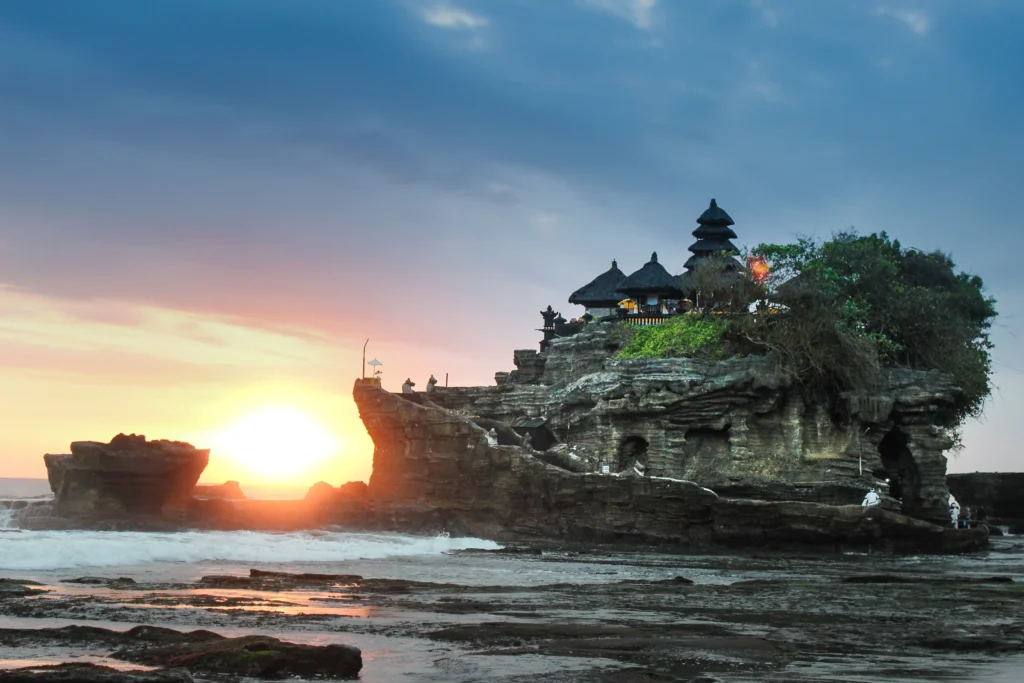
2. Beaches and Surf
Like Seminyak, Canggu is also a great place for beaches and surfing. You simply head to Pantai Berawa, Pantai Batu Bolong or Pantai Pererenan.
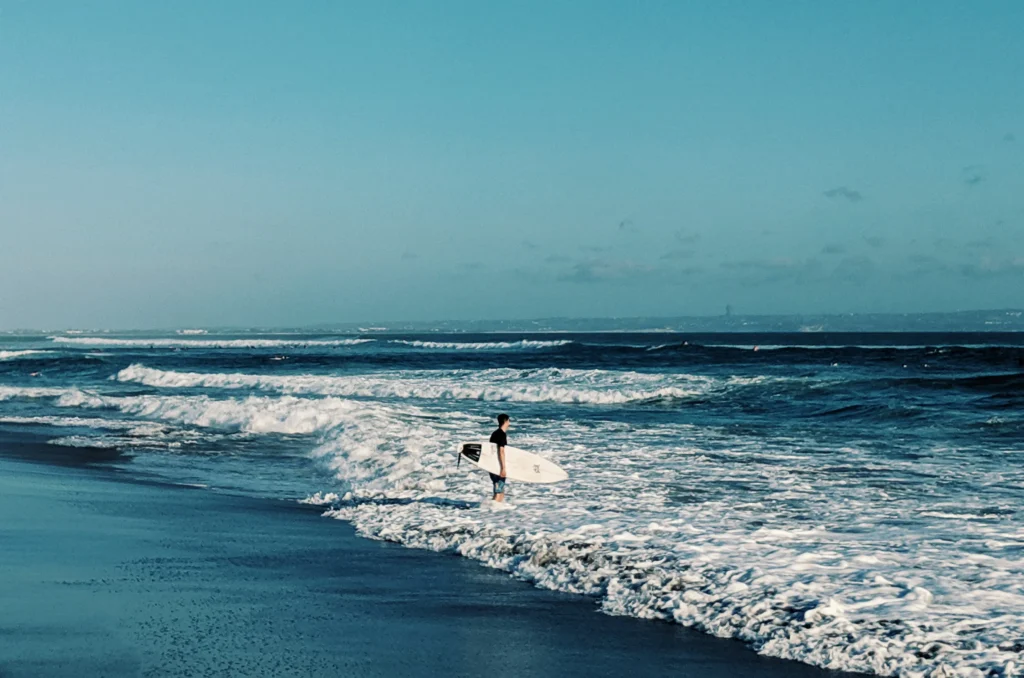
3. Digital nomad places
Canggu is a world capital for digital nomads. There are trendy cafes everywhere where you can sit with your computer and work in an inspiring environment. You will not have the time to try every one of them with only 14 days in Bali.
Many are located along Pantai Berawa Street, for instance, Milk & Madu (see location) and Nüde (see location).
Some places have also expanded from a cafe to a full hotel, huge coworking, and gym, for instance, Zin Cafe (see location).
The Sari Kitchen & Community (see location) is on multiple floors and is always bustling.
We can recommend the Avocado Factory (see location) for avocado lovers.
4. Party
Canggu is also a place where people like to party. It starts during the day and stops when you are exhausted. La Brisa is a beach club to enjoy during the day for a more chillout vibe. Old Man’s is ideal for partying hard at night. The legendary Café del Mar is also there. Mentioning Finn’s Club is mandatory as it is the most famous place.
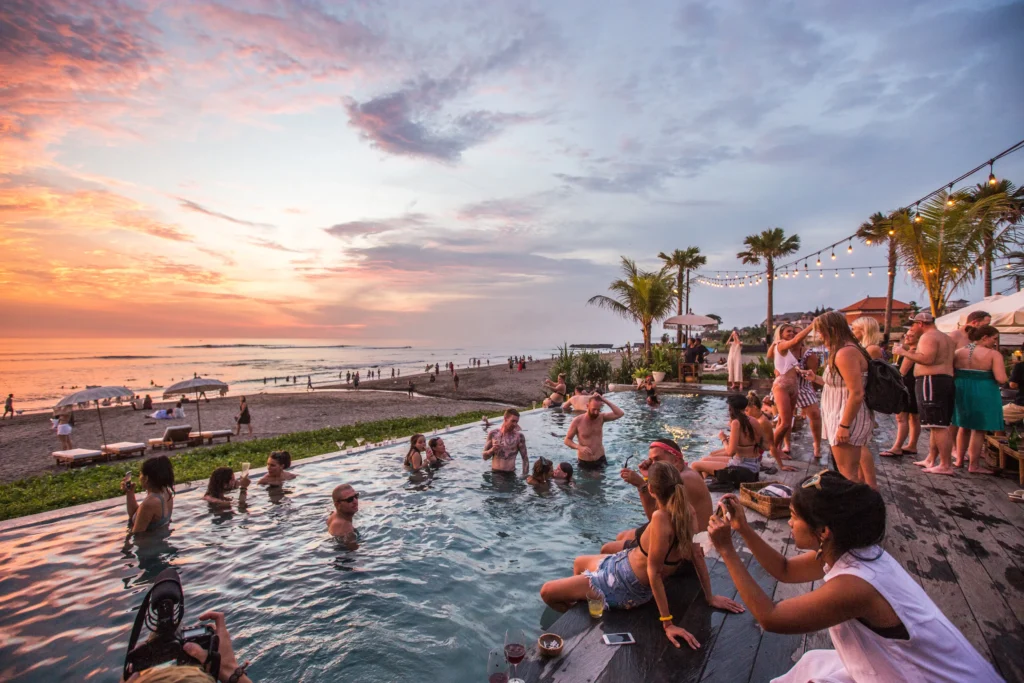
Why not go to (Insert place here)?
There are a lot of places to visit. With only 2 weeks in Bali, you must choose what is included and excluded on your 2-week itinerary. Here are reasons to help you make the best choice for your expectations.
Gili Islands. Many travelers choose to go to the Gili Islands. Or at least they used to go to the Gili Islands. Nowadays, it is better to visit Nusa Penida and Nusa Lembongan. A few years ago, these islands were not ready to receive tourists. The closeness is the significant advantage of Nusa Penida and Nusa Lembongan over the Gili Islands. It takes at least 4 hours to go to the Gili Islands, whereas it only takes 45 minutes to go to Nusa Penida. If you like the beach, you may want to avoid Ubud and go to the Gili Islands. But you may prefer to visit Thailand to enjoy beautiful beaches.
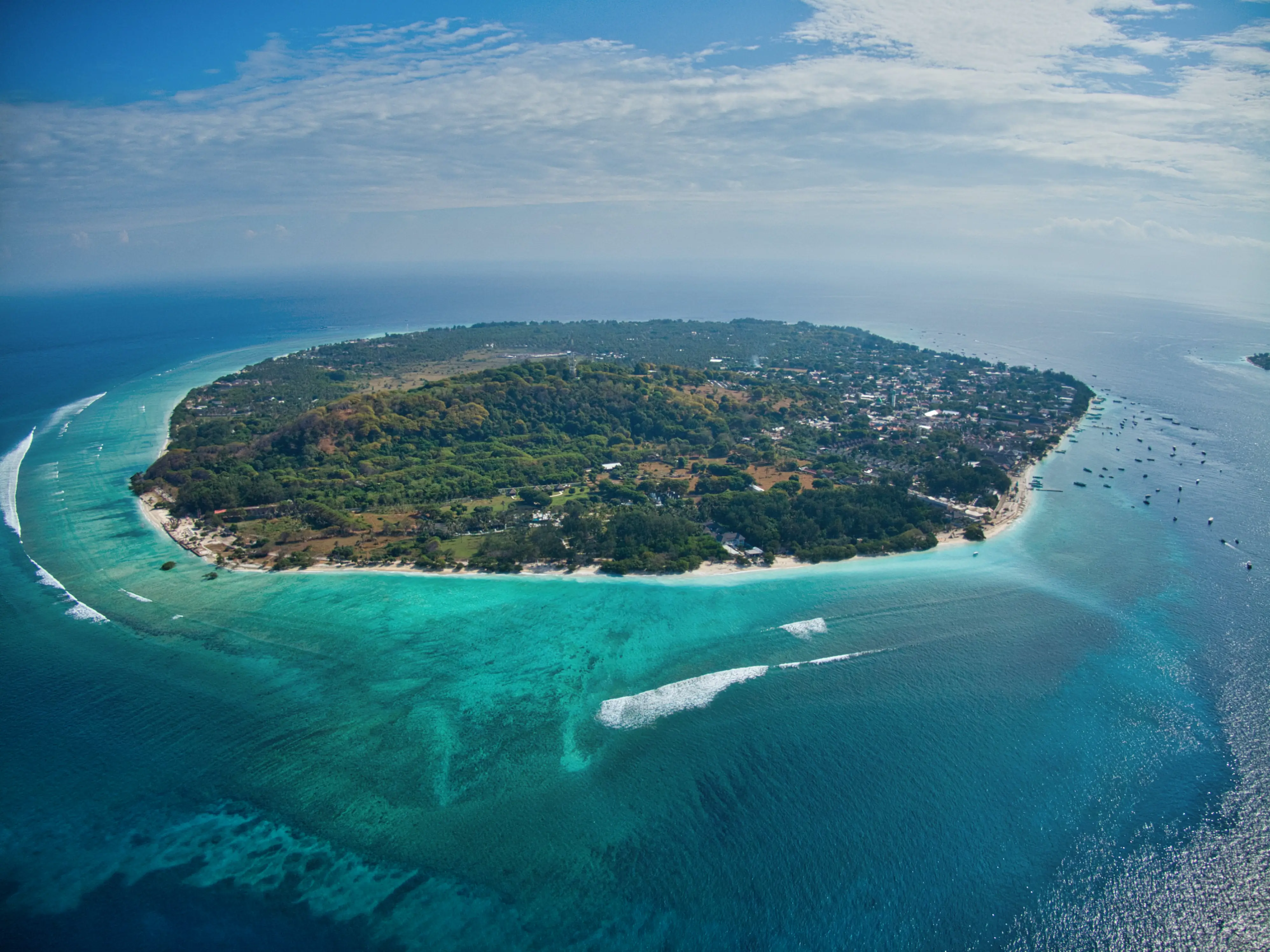
Uluwatu. Uluwatu is a great place for digital nomads but less great for tourists. The beaches are stunning between enormous cliffs. The drawback is that you need to rent a scooter to experience Uluwatu. Every hot spot, beach, or cafés is far from one another. You cannot get it by foot. For a few days, renting a scooter is inconvenient: find a rental, take the scooter, and get used to driving in Bali. For this reason, we chose not to go to Uluwatu on this 2-week itinerary in Bali. However, if driving a scooter in Bali is something you want to experience, do not hesitate to add it to your travel plan.
Sanur. Even though we must pass by Sanur harbor during these 14 days in Bali, it is not worth staying overnight. It is quieter and cheaper than Seminyak. It could be recommended for families. Overall, Seminyak or Canggu is a better pick.
Kuta. Kuta is located south of Seminyak. It is cheaper than Seminyak, so you can stay here instead of Seminyak when traveling on a budget.
Amed. Amed is a great place for scuba diving. If that’s not the main reason for your trip, it is best to avoid staying in Amed. The beach is made of black sand. It is not what travelers usually expect.
Munduk. If you want to get away from the busy places of Bali, Munduk is a great pick. It is a remote area with much fewer tourists than in other places. It can be recommended for a second trip to Bali. In Munduk, you will stay in the mountains. Some accommodations have awesome views down to the sea.
Lovina. Lovina is on the north side of Bali, the least developed for tourism. It is off the beaten path. Thus, you can stay here if you know what to expect. For a first trip to Bali of 14 days, it is not worth the detour.
Sidemen. Like Munduk, Sidemen is great for staying away from busy places. In Sidemen, you will stay in the middle of rice fields. Some accommodations have an incredible view of Mount Agung.
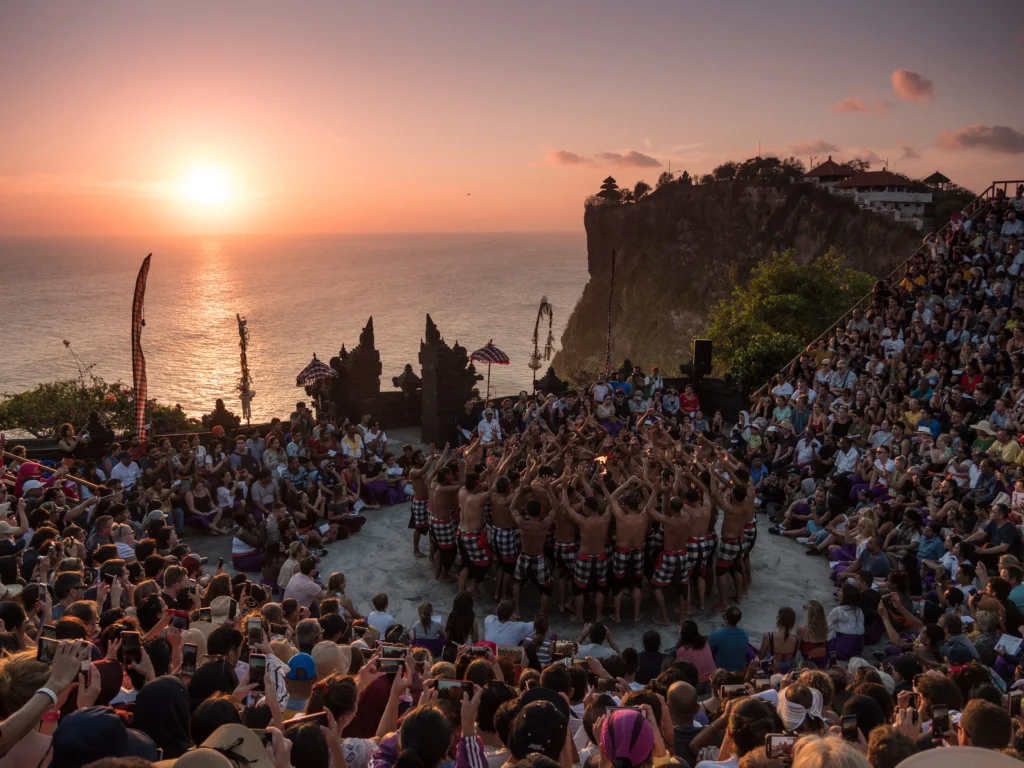
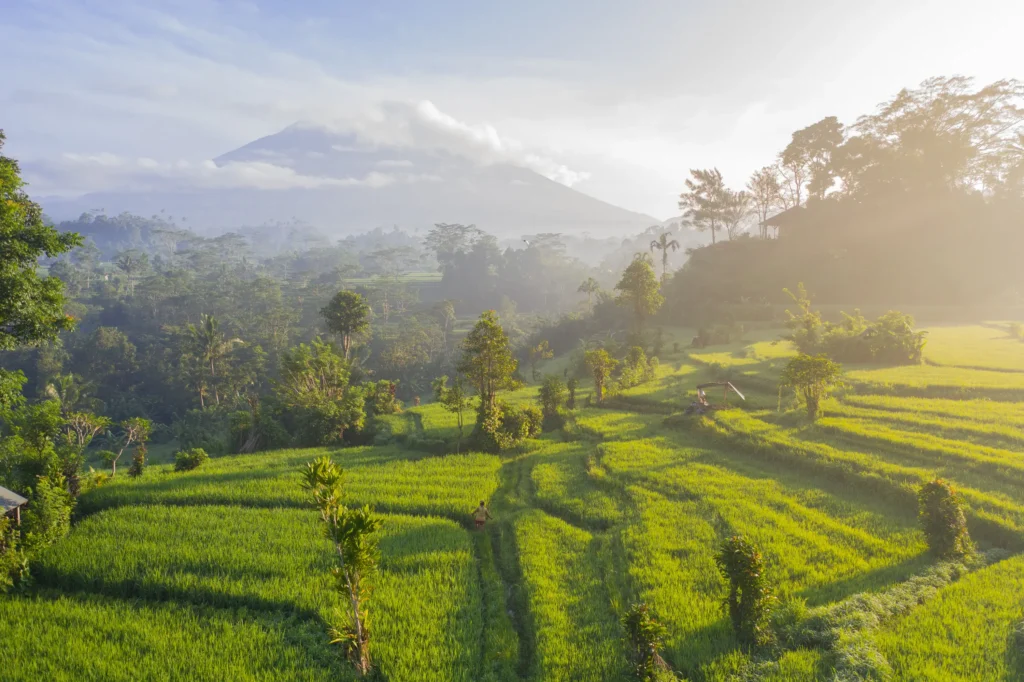
Tips when visiting Bali
Sarong and temples. A sarong is always required when visiting a temple. The sarong is a large length of fabric wrapped around the waist. A sarong is always rented for free at the entrance of a temple. The free sarongs may be hidden, so having a local guide with you is best. You will find many sarong sellers at every temple entrance. They can be insistent, pushy, and lie about the sarong requirements in the temple.
That’s all for our 2-week itinerary in Bali. There are incredible things for everyone in Bali. There is no doubt you will leave Bali with wonderful memories.



